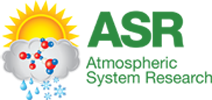Working Groups
The primary research objectives for the new ASR program are grouped according to the themes of aerosol life cycle, cloud life cycle, and aerosol-cloud-precipitation interactions, with working groups formed along these themes. The working group structure provides a forum for scientists to collaborate with each other. Each group includes a modeler and a measurement leader to facilitate communication and progress through the program. Principal investigators for ASR participate in at least one working group. Contact the working group leaders if you are new to ASR and would like to join a working group.
Aerosol Life Cycle
Working group leaders:
Allison McComiskey, NOAA Cooperative Institute for Research in Environmental Sciences
Jian Wang, Brookhaven National Laboratory
This working group seeks to improve the understanding of processes governing the spatial and temporal distribution of atmospheric particles and their chemical, microphysical, and optical properties. The goal is to reduce the uncertainty in climate model radiative forcing due to aerosols. Research topical areas include: (1) new particle formation, (2) aerosol growth, aging, and removal (3) the direct radiative impacts of aerosol, and (4) separating the natural versus anthropogenic aerosol influences on aerosol properties.
Cloud Life Cycle
Working group leaders:
Anthony Del Genio, NASA Goddard Institute for Space Studies
Matthew Shupe, NOAA Cooperative Institute for Research in Environmental Sciences
This working group seeks to improve the representation of large and small-scale cloud properties in GCMs (e.g., cloud cover, precipitation, structure, lifetime, or reflectivity), and reduce the associated uncertainties in climate simulations. Research topical areas include: (1) dynamics, (2) microphysics, and (3) cloud-radiation interaction. The research will involve both direct observations and cloud property retrieval, as well as process parameterization improvement or development.
Cloud-Aerosol-Precipitation Interactions
Working group leaders:
Steven Ghan, Pacific Northwest National Laboratory
David Turner, University of Wisconsin-Madison
This working group seeks to improve our understanding of the interactions among, aerosols, clouds, and precipitation in climate models. Research topical areas include: (1) the impact of aerosols on cloud particle formation processes, (2) radiative impacts of microphysical and macrophysical cloud properties influenced by aerosol, (3) cloud effects on aerosol by vertical transport, aqueous chemistry, and removal, and (4) precipitation efficiency influenced by several related processes including cloud depth, collision/coalescence, and entrainment.


Comments?
We would love to hear from you! Send us a note from here.